
Vice Admiral Richmond K. Turner (USN) graduated from the Naval Academy in 1908, serving on battleships during the Great War. In 1926, however, he made a major career change and was rated a Naval Aviator. This transfer to the air arm was followed by a variety of aviation staff assignments, including a spell as executive officer of the carrier USS Saratoga (CV-3). The last of this string of staff appointments was as Commander, Aircraft, Battle Force of the US Fleet and he subsequently took command of a cruiser and then attended the Naval War College. He was director of the Navy Department’s War Plans Division when war broke out and, in the summer of 1942, Turner took command of amphibious forces in the South Pacific. His experience as a staff officer and in command of both air units and ships of the line proved valuable during the bitter campaign in the Solomons, but could not prevent him suffering the only defeat of his career at Savo Island (9 August 1942). He took command of Fifth Fleet Amphibious Force, in August 1943, to perfect landing force operations in preparation for attacks on the Gilberts and Marshalls. He commanded both the Joint Expeditionary Force and Northern Attack Force for the Saipan and Tinian operations, later oversaw the Guam and Okinawa landings, and directed the amphibious forces of both Third and Fifth Fleets. In his post-war career he served as the US Navy representative to the UN Military Staff Committee. Admiral Turner retired in 1947 and died in 1961.

Col Franklin A. Hart, Commander, 24th Marines, discusses the landing plan for Namur Island with his regimental staff. The white tags on the terrain board identify defenses, installations, and key terrain features.
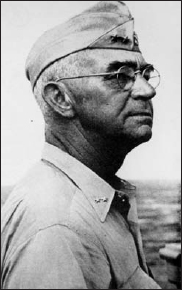
Vice Adm Richmond K. Turner commanded both the Joint Expeditionary Force (TF 51) and Southern Attack Force (TF 52), the latter assigned to seize Roi-Namur in northern Kwajalein Atoll. Turner was also Commander, Fifth Amphibious Force, the force providing the amphibious warfare ships for Operation “Flintlock”.
Until commissioned in the US Marine Corps in 1905, Lieutenant General Holland M. Smith (USMC) was a practicing Alabama lawyer. He served in the Philippines, Panama, Dominican Republic, and France in World War I but it was in the Dominican Republic that he received his most appropriate nickname, “Howlin’ Mad”. Smith attributed his own aggressive style to having adopted the philosophies of Napoleon Bonaparte, on whom he had read widely. Following his graduation from the War College in 1921, his service on the Joint Army-Navy Planning Committee, Marine Corps Schools, Post Quartermaster, Force Marine Officer for the Battle Force, Chief of Staff of the Department of the Pacific, and Director of Operations and Training at Headquarters, Marine Corps, as well as actually commanding troops, gave him a wealth of experience. He was to draw heavily on this as he molded the Fleet Marine Force (FMF) into probably the world’s most formidable amphibious assault force. In 1939 he took command of the 1st MarBde, which was expanded into the 1st MarDiv in 1941. Shortly thereafter he took command of Amphibious Force, Atlantic Fleet and then Amphibious Corps, Pacific Fleet, which was in turn re-designated V Amphibious Corps (VAC) in August 1942. Promoted to lieutenant general in May 1944, Smith led VAC during the operations to capture Tarawa, Makin, Roi-Namur, Kwajalein, and Eniwetok. For the Marianas operation, he was designated Commanding General, Expeditionary Troops, and, while still holding this command, in July 1944 gave up VAC to take command of the newly activated FMF, Pacific, overseeing all Marine forces in the Pacific Theater. A controversial figure, Smith was a consistent, ruthless and outspoken critic of the Army and Navy. When this eventually became a liability to joint operations, he was reassigned in July 1945. He retired in 1946 and died in 1967.
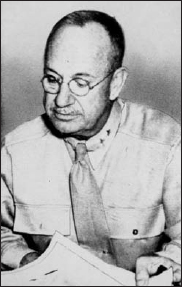
Fiery LtGen Holland M. Smith commanded V Amphibious Corps, which served as the Expeditionary Troops (TF 56) responsible for land operations in the Marshall Islands.
Major General Harry Schmidt (USMC) was commissioned in the Marine Corps in 1909 from Nebraska. He served overseas on Guam, in the Philippines, Nicaragua, and served four tours in China. Graduating from the Army Command and General Staff School in 1932, Schmidt served in numerous command, staff, and instructor positions, including Headquarters, Marine Corps. Before taking command of the newly activated 4th MarDiv in August 1942, he was Assistant to the Commandant of the Marine Corps. He led the Division on Roi-Namur and Saipan, before taking command of VAC on 12 July 1944, allowing LtGen Smith to oversee the Guam operation. He commanded VAC through the rest of the war, including the assault on Iwo Jima, and then served as part of the occupation force in Japan. On returning from Japan, he led Marine Training and Replacement Command until retiring, as a full general, in 1948. General Schmidt died in 1968.
Major General Charles H. Corlett (USA) graduated from the Military Academy in 1913 to serve in France during World War I in staff assignments. He resigned from the Army in 1919, but returned to duty the next year and was assigned to the coast artillery. Corlett graduated from the Command and General Staff College in 1923 and later served on its faculty as well as on the War Department General Staff, was Provost Marshal of Hawaii, and commanding officer of the 30th Infantry. Taking command of the 7th InfDiv in April 1943, he doubled as commander of Amphibious Training Unit 9, the Kiska Task Force, and was the ground force commander for the invasion of Kiska Island in the Aleutians. After “Flintlock” he went on to command XIX Corps in Europe from March to October 1944 until relieved for health reasons. He was then on the Twelfth Army staff until taking command of XXXVI Corps in 1945. Corlett retired in 1946 and passed away in 1971.
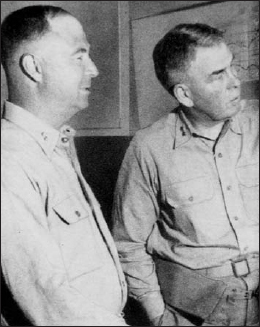
Rear Adm Richard L. Conolly (left), Commander, Northern Attack Force (TF 53), which would deliver MajGen Harry Schmidt’s (right) 4th MarDiv to Roi-Namur.
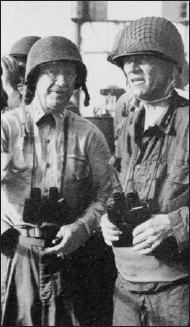
LtGen Holland M. Smith (left) confers with MajGen Charles H. Corlett, Commanding General, 7th InfDiv responsible for Kwajalein Island in southern Kwajalein Atoll.
A Louisianan commissioned in the Marines in 1916, Brigadier General Thomas E. Watson (USMC), served in China, Nicaragua and on three separate occasions in China. He served in the War Plans Division, Headquarters, Marine Corps from 1938 to 1942, having previously graduated from the Army War College, and then commanded the 3rd MarBde in Western Samoa. He then led the brigade-sized TacGrp 1 during the capture of Eniwetok, subsequently taking command of the 2nd MarDiv in April 1944. He commanded that formation through the Saipan and Tinian operations and supported the Okinawa assault, although here only one-third of the Division served ashore. He took over as Director of Personnel, Headquarters, Marine Corps in July 1945 and commanded FMFPac from 1948 to 1950, after which he retired as a lieutenant general. He died in 1966.
Vice Admiral Kobayashi Marasmi (IJN) (misspelled “Marashi” in official US histories) graduated from the Naval Academy in 1906 to serve mainly on cruisers and smaller ships. He graduated from the Naval College in 1917, specializing in navigation, and was later an instructor at the same institution. His first command was a gunboat in 1923–24. From 1925 to 1928 he resided in the United States, where he learned English and served as an assistant naval attaché and again as attaché from 1932 to 1934. He commanded the battleship Yamashiro in 1936 and then became chief of staff of the 4th Fleet. After this he served in a number of naval base command assignments, was promoted to vice admiral in October 1941, and took command of the 4th Fleet on 1 April 1943 with his headquarters on Truk. For a brief period prior to the attack he maintained a temporary headquarters on Kwajalein. He was replaced on 19 February 1944, possibly because of ill health. He briefly served on the Navy General Staff and was placed in the Reserve in May 1944. He died in 1977.
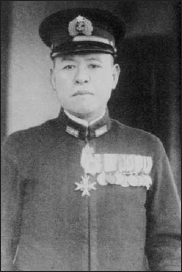
Rear Adm Yamada Michiyuki commanded the 24th Air Flotilla based on Roi-Namur and died during the pre-invasion bombardment on Namur.
Rear Admiral Yamada Michiyuki (IJN) graduated from the Naval Academy in 1914 and became a flyer in 1918. After visiting Britain in 1920 he served in numerous flying units receiving his first command assignment in 1936. He continued to command land-based flying units early in the war and was given command of the 24th Air Flotilla responsible for the air defense of the Marshalls on 20 January 1943. He had been promoted to rear admiral2 in November 1943 while commanding the Kasumigaura Air Group, a fighter unit. He was killed on 28 January 1944 on Namur during the pre-invasion bombardment.
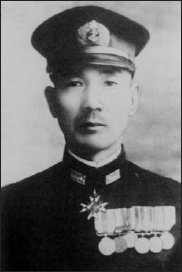
Rear Adm Akiyama Monzo was the commander of the 6th Base Force responsible for the guard forces and other defense forces in the Marshall Islands. He died on Kwajalein Island.
Rear Admiral Akiyama Monzo (IJN) served aboard battleships and cruisers after graduating from the Naval Academy in 1919. He became a noted gunnery officer attending numerous gunnery courses. His first command was a supply ship in 1936, however. From 1938 he began receiving base force assignments. In 1943 he was promoted to rear admiral2 and assigned to the 4th Fleet staff. In November he assumed command of the 6th Base Force responsible of defense of the Marshalls. On 2 February 1944 he was killed on Kwajalein.
Major General Nishida Yoshimi (IJA) (misspelled “Yoshima” in official US histories) was the commander of the 1st Amphibious Brigade (AmphBde) at Eniwetok. He was a graduate of the IJA Military Academy and served as an infantry regiment commander in China. In late 1942 he took command of an independent garrison unit in Manchuria, which was converted to the 1st AmphibBde in November 1943. He died in his headquarters on Parry Island, Eniwetok, on 23 February 1944.